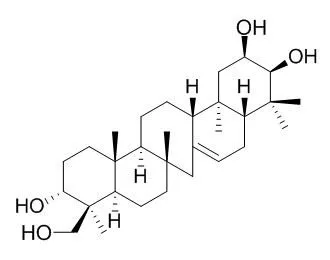| Structure Identification: |
| Yakugaku zasshi journal of the Pharmaceutical Society of Japan,1974, 94(8):970-90. | | Chemotaxonomic studies on the triterpenoids of Lycopodium plants (Japanese)[Reference: WebLink] | Fifty-one samples of Lycopodium plants (mostly Japanese species), including 17 species and 3 varieties, were collected and their triterpenoid constituents were examined firstly by comparing microchemically and then characterized by isolating them after alkaline hydrolysis.
METHODS AND RESULTS:
Discussions are made on thin-layer chromatography and chemotaxonomy of lycopodium triterpenoids, isolation and characterization of triterpenoids constituents, relationship between location of growth and the constituents, and relationship between species and the constituents. All the plants examined contained triterpenoids of serratane group or its assumed precursor, α-onocerin, the former including 13 new triterpenoids, 16-oxoserratenediol, 16-oxo-21-episerratenediol, 16-oxodiepiserratenediol, 16-oxoserratriol, 16-oxolycoclavanol, lycocryptol, 21-epilycocryptol, diepilycocryptol, Lyclaninol, lyclanitin, 16-oxolyclanitin, lycernuic acid-A, and lycernuic acid-B, and two new glycosides of serratenediol and tohogenol. A new bisnortriterpenoid, clavatol, was isolated from L.clavatum. All these Lycopodium plants can be divided into three classes according to their major triterpenoids ; α-onocerin (L.clavatum, L.sitchense, L.obscurum, L.casuarinoides, L.inundatum), serratenediol (L.serratum, L.somae, L.cryptomerinum, L.chinense, L.sieboldii, L.fargesii, L.fordii, L.cernuum, L.phlegmaria), and 21-episerratriol (L.annotinum). Some of them (L.sitchense, L.annotinum, L.cernuum, and L.complanatum) showed variation in constituents depending on the locality of growth.
CONCLUSIONS:
Particularly, L.complanatum collected in Hokkaido contained α-onocerin as a major component, while the same plant from Taiwan did not contain α-onocerin but had 21-episerratriol as the major triterpenoid. Some plants of different species (cf. L.fargesii and L.fordii) were not distinguishable by their triterpenoid constituents suggesting their close relationship. |
|






 Cell. 2018 Jan 11;172(1-2):249-261.e12. doi: 10.1016/j.cell.2017.12.019.IF=36.216(2019)
Cell. 2018 Jan 11;172(1-2):249-261.e12. doi: 10.1016/j.cell.2017.12.019.IF=36.216(2019) Cell Metab. 2020 Mar 3;31(3):534-548.e5. doi: 10.1016/j.cmet.2020.01.002.IF=22.415(2019)
Cell Metab. 2020 Mar 3;31(3):534-548.e5. doi: 10.1016/j.cmet.2020.01.002.IF=22.415(2019) Mol Cell. 2017 Nov 16;68(4):673-685.e6. doi: 10.1016/j.molcel.2017.10.022.IF=14.548(2019)
Mol Cell. 2017 Nov 16;68(4):673-685.e6. doi: 10.1016/j.molcel.2017.10.022.IF=14.548(2019)